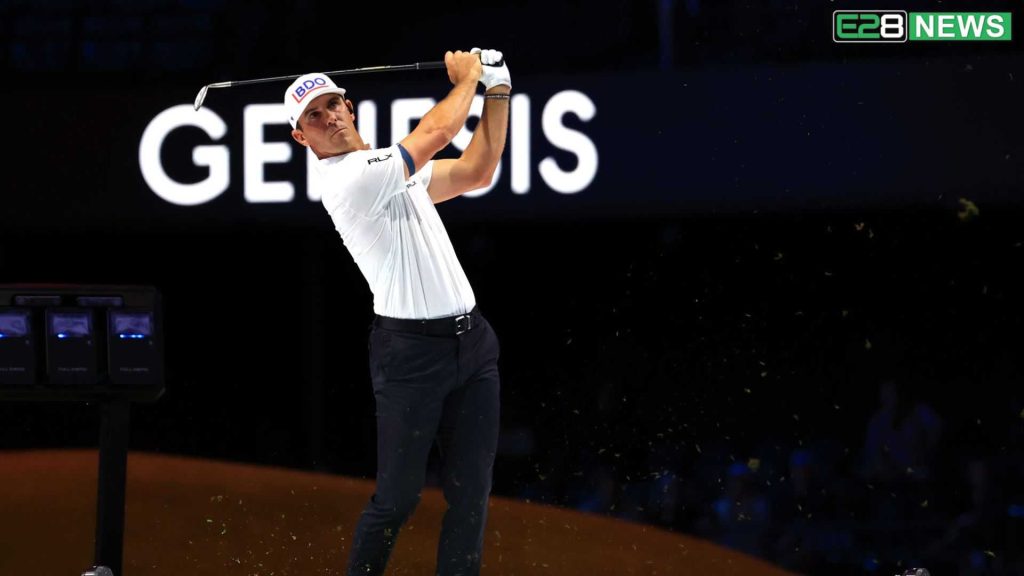As Billy Horschel’s golf ball rolled into the hole, he celebrated with excitement—sprinting, jumping, swearing, and throwing his club. It was a high-energy, dramatic moment that became the highlight of TGL’s debut season.
That downhill putt, with its tricky breaks, helped Horschel and his Atlanta Drive teammates, Patrick Cantlay and Justin Thomas, secure a win against the New York Golf Club team. This happened in the second match of the best-of-three final series, where they came back from 3-0 down to win 4-3, taking a strong 2-0 lead.
The thrilling finish was exactly what the Tech-infused Golf League needed—an exciting ending that Tiger Woods and Rory McIlroy had hoped for when they created this lively, indoor simulator version of golf.
The decisive putt, with its unexpected twists, could also symbolize the season itself—full of ups and downs. There were technical issues, one-sided matches, rule changes, and mixed reactions from fans. But despite all that, the TGL achieved its goals.
It drew solid TV ratings, helped showcase players’ personalities, and attracted a younger audience. The median age of ESPN viewers was 51, compared to the usual 63 for PGA Tour and LIV events.
The TGL (Tech Golf League) aimed to attract viewers by playing mainly on Monday and Tuesday evenings. It started off strong, with over 900,000 people in the US tuning in for the first match in January, but viewership declined to around half a million on average.
The early matches lacked excitement, and players seemed to struggle with the format. There was a noticeable awkwardness between the $21 million prize money event and the casual environment that made it feel less serious. In one game, Tiger Woods misread a distance by 100 yards and laughed it off. This wouldn’t happen in a regular tour event, and it hurt the league’s competitive reputation.
The “hammer” rule, which made a hole worth double points, didn’t work at first but became more effective after the rules were changed to allow three “hammers.” This strategy played a big role in determining the title and added a competitive edge.
The TGL brought the kind of excitement that LIV Golf, a rival tour, has been trying to create. LIV has had limited success in terms of buzz, with their Adelaide tournament being one of their highlights. Horschel’s dramatic actions on the course were reminiscent of LIV’s style but felt fitting as the TGL reached its playoff stage. Patrick Cantlay’s steady play also kept the serious side of the event intact.
Cantlay’s chip against Cameron Young helped secure Atlanta Drive’s victory, just after Horschel’s dramatic putt. LIV’s Phil Mickelson praised the TGL on social media, noting it could be good for the game if successful, as it would allow golf fans to experience the sport in a way other fans do in different sports.
Currently, LIV players aren’t eligible for the TGL because it’s backed by the PGA Tour, though that could change if the two tours reach an agreement. Brooks Koepka from LIV attended a match in February, showing interest.
A delay in the start of the first deciding match highlighted where TGL stands in the broader sports world, with a Women’s NCAA basketball game running late on ESPN2. Despite this, the TGL is here to stay. The project has strong backing, with 11 of the top 15 golfers in the world involved, and the 250,000-square-foot Sofi Centre venue, built at $50 million, adds credibility. There are plans to add a second venue on the West Coast in the future.
TMRW’s Mike McCarley, co-founder of the project with Woods and McIlroy, says they’re in the middle of an expansion process, with potential new team owners visiting each match. The league is supported by top American sports investors, including owners of the Atlanta Falcons, New York Mets, and Milwaukee Bucks.
Serena Williams is a co-owner of the Los Angeles team, which has raised questions about why the TGL didn’t include top LPGA stars like Nelly Korda and Lydia Ko.
Like LIV, the TGL might struggle to win over traditional golf fans due to its louder, more energetic environment. However, the league is meant to expand the sport’s audience, not just cater to existing fans. The players seem to enjoy it and have found it worthwhile to include in their early season schedules.
Horschel, after winning his share of the $9 million prize, said the league exceeded expectations. He described the experience as awe-inspiring, comparing it to the excitement a football or basketball player feels when walking into a big stadium or arena. Playing golf in such a unique environment with music and a live audience has been a great experience for him.

